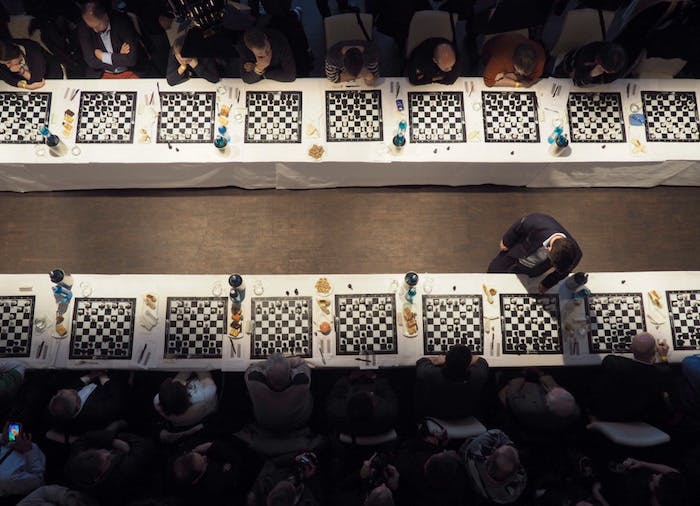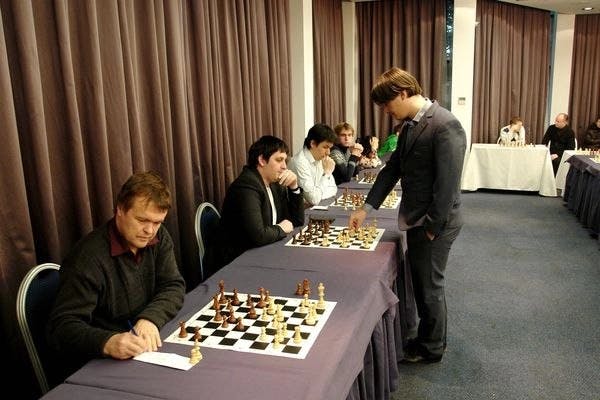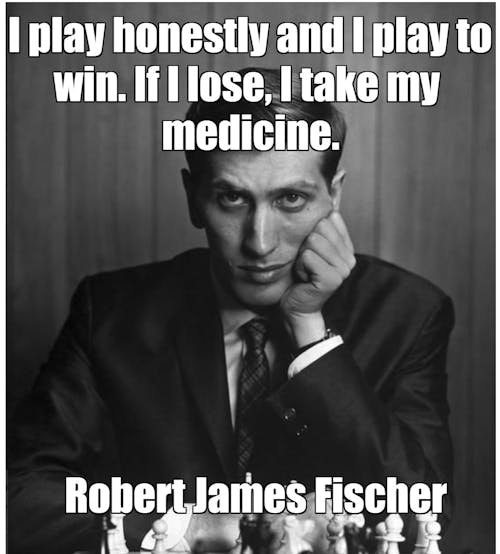Are you sure you want to delete your account?
(This will permanently delete all of your data - purchases, game scores, ratings, etc)
Change your username
Your current username is: guest
Change your account email address
Your current account email is:
Redeem your Fampay code here!
Use your Fampay code to get access to the Play Magnus Plus Membership!

Have You Ever Played in Simultaneous Exhibitions?
For most of us, the only chance to feel what it’s like to face a much stronger opponent is to enroll in a simultaneous exhibition. Playing against a world champion or a top GM is usually a memorable experience that we cherish for the rest of our lives, especially if we do well.
My first experience of playing in a simul was in Canada in 1999. John Hush, the head of our chess club, kindly took on a few volunteers from the H.B. Beal Chess Club. Our game lasted quite long and, being the last one, was adjourned. I recall analyzing the endgame at home and even sharing some thoughts about the position with my Dad. I believe I won eventually.
Years later, I discovered John's YouTube channel and realized he is reasonably well-known for his entertaining videos related to Math. This was no surprise to me at all since he is a fantastic teacher.
A bit, I used to briefly attend a chess club and tried my hand at giving simuls to kids rated about 1400-1600. My takeaway from the process was that this activity requires good physical shape. You get tired of running in circles, and the positions in front of you start to blur. Admittedly, this can probably be overcome with a lot of practice, but I didn't have that many opportunities. In other words, giving a simul is much tougher than it seems!
In the blitz club that I frequented in the early 2000s, some of the players were old-school veterans who had a chance to face chess legends in simuls. One of the regulars of our club defeated Mikhail Tal back in the day, drew Anatoly Karpov, and had some other remarkable results against World Chess Champions. I saw the games in his book and was quite impressed. Also, apparently, he was very proud of those achievements, and his friends would sometimes compliment him after a game, saying things such as, "What else did you expect from a guy who beat Tal?".
Nevertheless, being an ambitious person, I was more interested in confronting strong players one-on-one and resorted to simuls only due to a lack of opportunities to play them live. At that time, the go-to place for simuls was ICC, where I collected a certain number of titled players' scalps. I never considered those victories "legit", but they were still a good preparation for eventually facing the same guys over the board one vs. one.
When I came to Taganrog in 2014 to compete in the Dvorkovich Memorial, Alexander Morozevich was the first person I saw in the restaurant. He sat at the table alone, wearing his trademark rucksack. and staring into the distance We both played in the rapid portion of the event. Alas for me, our performances were significantly different. He scored 8/11, while I got only 5 points. Anyway, I was excited about the opportunity of playing against Moro in a simul since, at some point, he used to be my favorite chess player. Being well-known in small circles helped me book a sit without any problems.
One does not simply beat Garry Kasparov in a simul!
Unlike Kasparov or some other legends who prefer to keep the level of the participants in check in order to secure flawless victories, Morozevich said he was OK with opponents of any strength challenging him. One of my chess pals, an IM, confessed he had a hard time restraining himself not to sign up! Anyway, Moro took on quite a strong field. Most of his opponents, myself included, were participants of the Russian Cup in Taganrog. The former world #2 played unbelievably fast. When the position got complicated, I remember not being able to ponder it for long enough before he came to my board, piercing me with his fiery gaze and waiting for a reply. I recall being disappointed about not performing as well as I could have. The GM's unusual opening choice took me by surprise, and even though his play was not perfect either, it was good enough to finish me off. The fact that he destroyed everyone else in the simul was of little consolation to me. You can check out the infamous game here.

I am the guy wearing the white shirt. There were a few other tables around the hall.
Over the course of my life, I have received questions from many people on how to do their best in a chess simul. Also, there are threads about it on the Internet, which is an indication that giving some advice publicly might be useful.
First of all, play to win. Amateur players often feel intimidated by the identity of the simul giver and mentally resign before the game even begins. Also, some of them have an irritating trait of hoping to “last longer” than anyone else, even if it requires suffering in a totally lost technical endgame. What matters is how enjoyable and interesting the game is, as well as the outcome. There is no accomplishment in going for an inferior position right away and hoping to earn a draw. Instead, be brave and play to win!
Secondly, stick with the openings you like best and know relatively well. This advice is identical to the one related to facing stronger opposition one-on-one. Even if you lose, it is better to receive a lesson in one of your pet lines than to succumb in 15 moves because you didn’t know how to handle a sharp gambit line that you don't normally play. This is one of the most popular misconceptions about simuls. People walk around asking, "How do I trick the GM by using some offbeat line?" Given the difference in opening knowledge and playing strength in general, you are more likely to trick yourself this way!
Thirdly, keep in mind that in simuls masters have a limited time per move and a high workload. They get tired and oversee things. Hence, the more complicated and tactical the game is, the more unpleasant it is for them. If your position is suspicious, try to reach murky waters. Also, if you are MUCH weaker than the simul giver, one of your best chances is to play stubbornly and set up little traps along the way, hoping that the opponent will become careless and blunder due to fatigue or irritation.
Fourthly, try it out to get a better idea of what it feels like to give a simul. You get a way more balanced view this way, realizing how it feels to be in the shoes of someone who faces a few opponents at a time. If you are not strong enough to take on club players, you can always experiment with your friends and relatives.
I wish you the best of luck playing in simuls and giving them!
P.S. The best way to play in a simultaneous exhibition is to monitor strong events and check out if they have such an event on the agenda. An alternative is to check out a site such as Chess24.com, where you can play in simuls or even one-on-one banter blitz games against top GMs. Or, if you prefer a fair fight, you can always download the Play Magnus app and take on Magnus Carlsen, Judit Polgar, Wesley So, and other chess celebrities.

